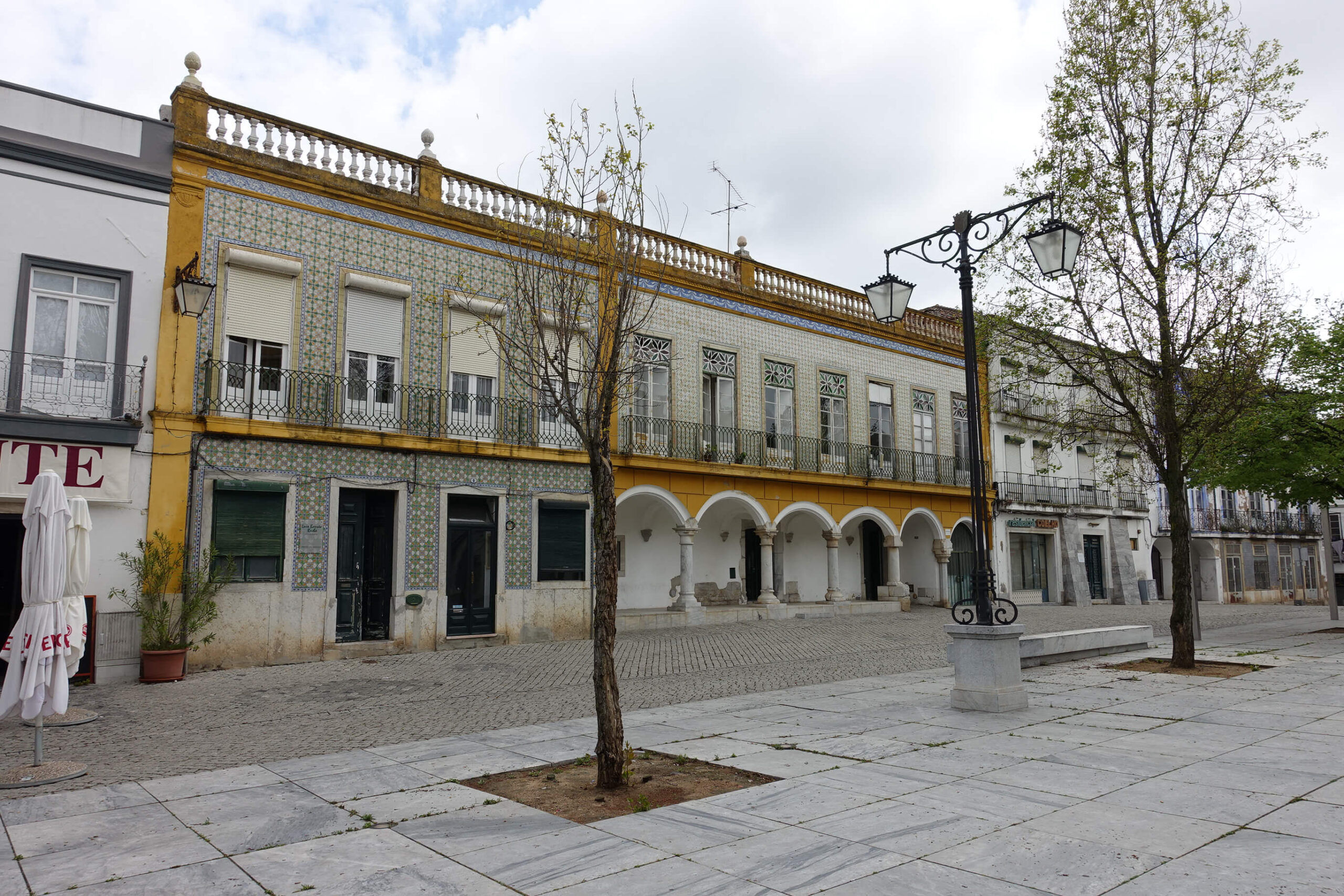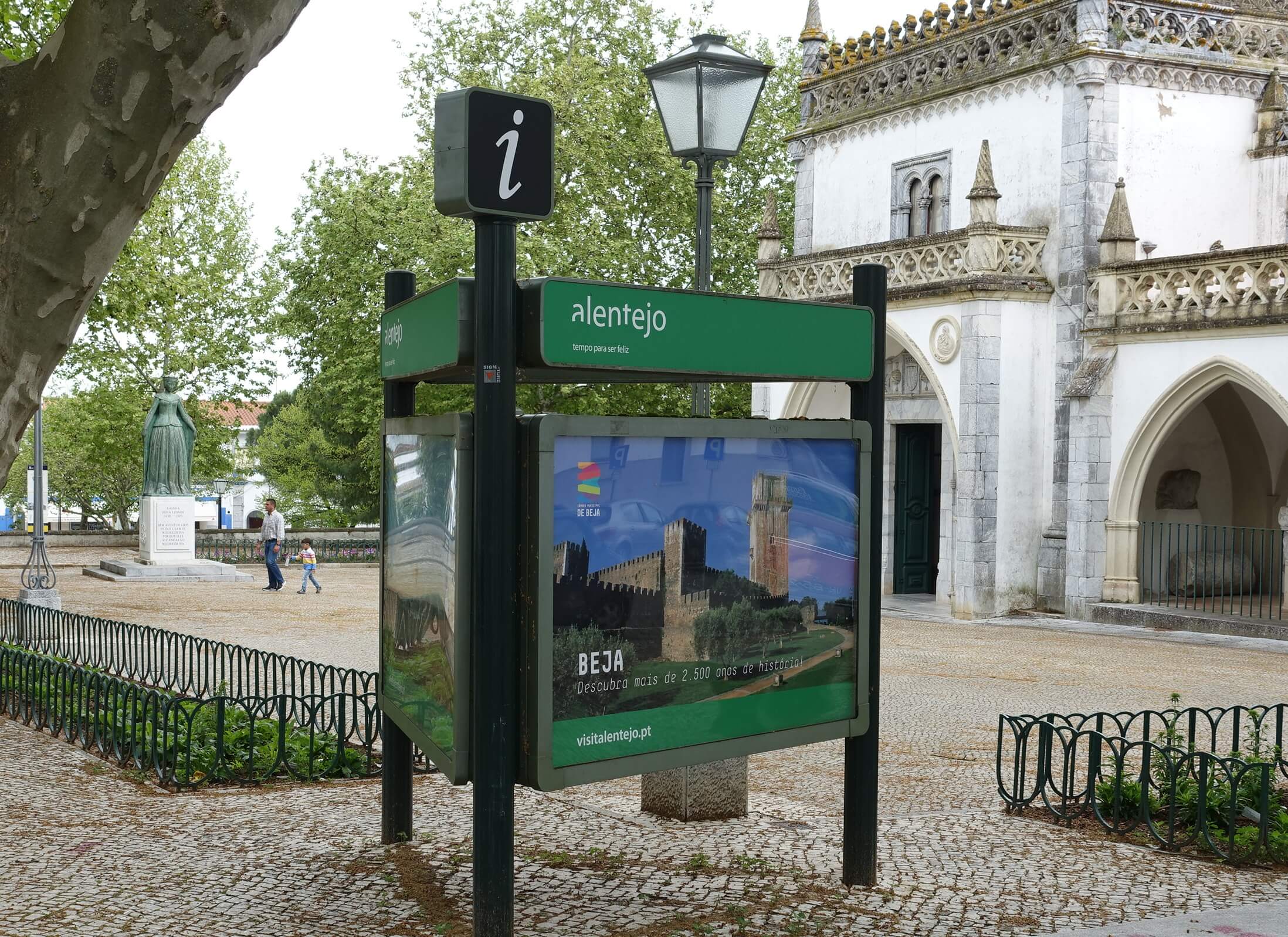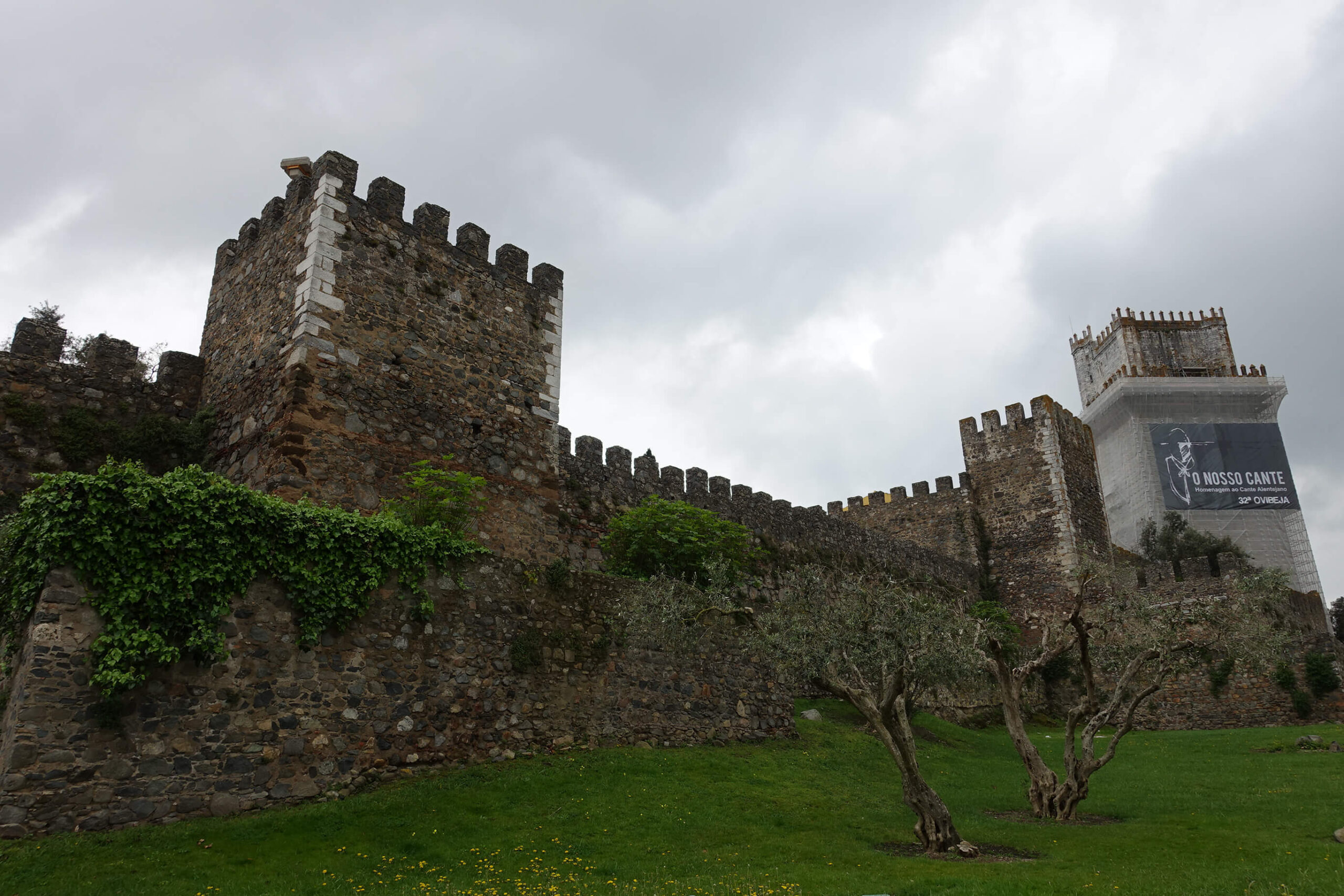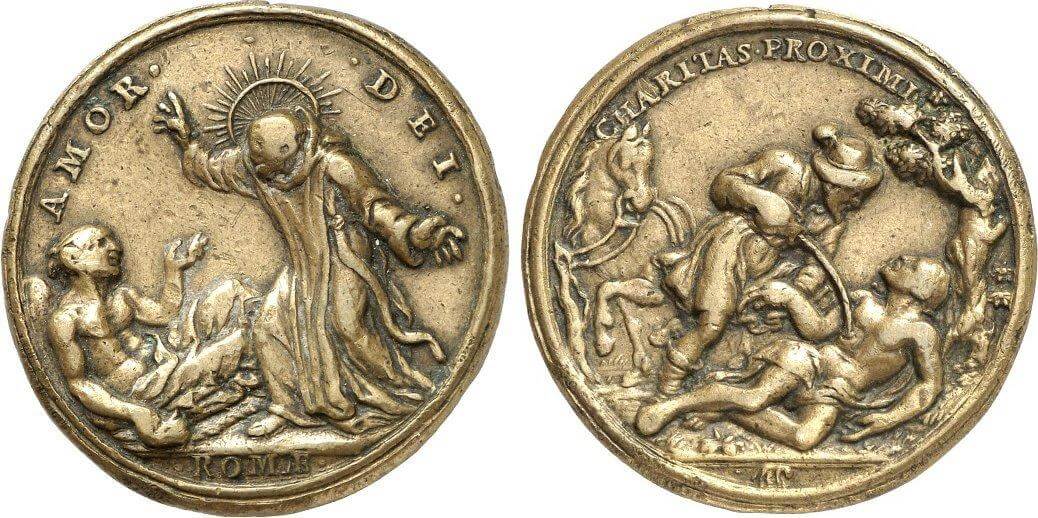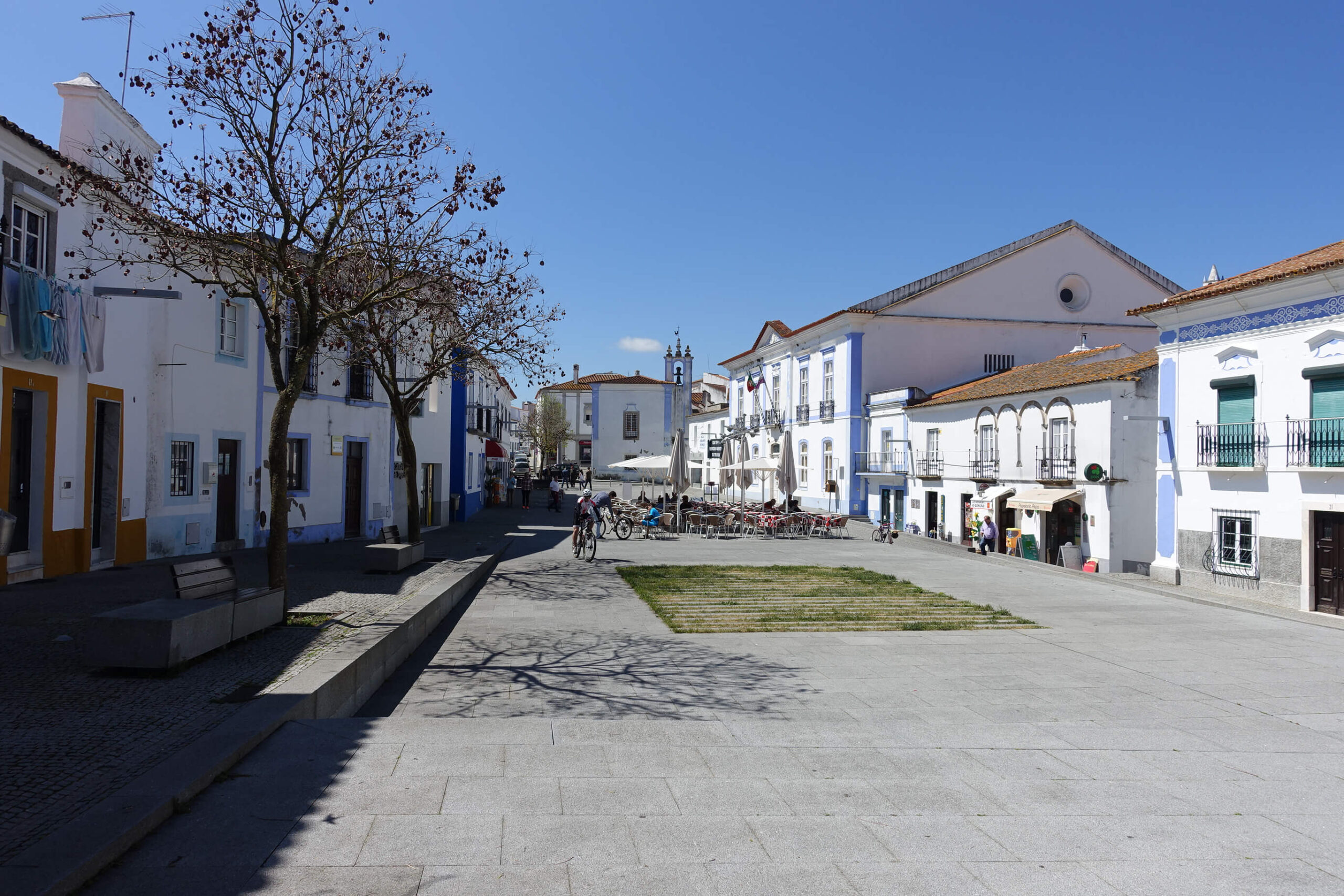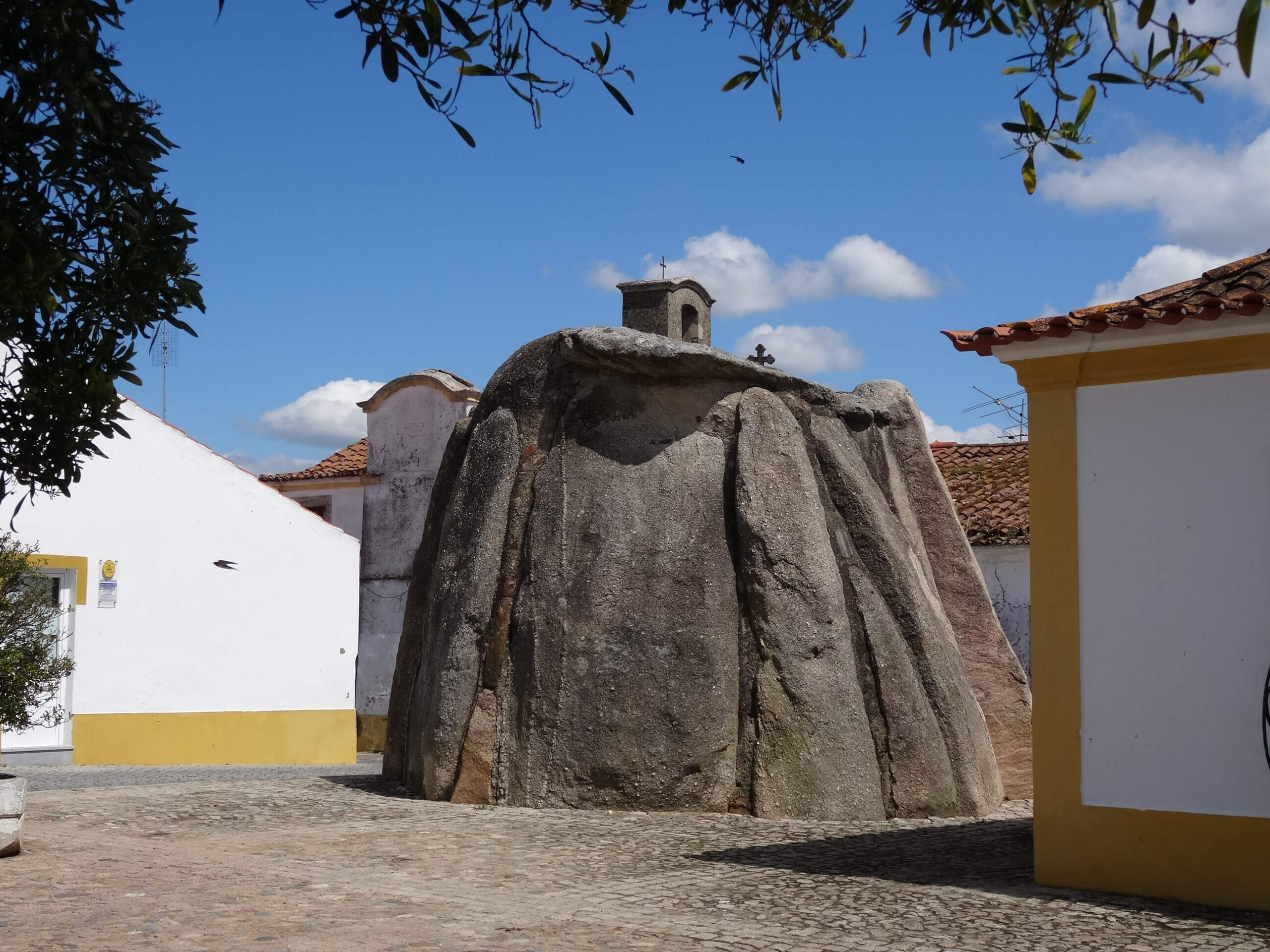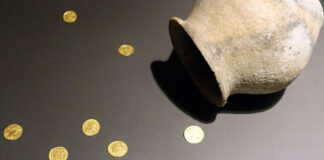Alentejo is not exactly the centre of the universe. Its picture-perfect scenery is still very beautiful. Correction: It is without constant rainfall.
Friday, 10 April 2015
Our original plan had been to drive to Troia. We had heard many good things about the excavation. Apparently, they had discovered a Roman garum factory! The only problem: The excavation is only open to visitors after giving notification by phone in advance, as the travel guide informed us. That is all well and good if you speak fluent Portuguese, but with my rudimentary language skills?! So we decided against driving 300 km and possibly ending up before closed gates once more. Instead, we planned a day trip to Beja, referred to as the “Queen of the planes” in my guide book.
Well, let us put it that way: We found it somewhat difficult to discern what was so royal about Beja at first sight. It looked bleak and the gloomy weather, which looked like it might turn into rain any minute, did not help that impression. Neither could we immediately locate a tourist information or at least a city map indicating the major sights. Instead, the town was plastered with “informative” posters with landscape shots of Alentejo. How useful!
Our mistake had probably been arriving in Beja at the wrong time (not the first time we did this), during lunch hour. In any case, lots of doors suddenly opened to release lots of people onto the streets where they went home, to the next bar or pastry shop. We followed suit, drank coffee and coke, and ate three pieces of pastry, which was a truly good deal for 4 euros. Life in Portugal is cheap for us.
At 2 p.m. sharp all museums reopened. Unfortunately, we were pretty annoyed by the pouring rain that was coming down on us at the time (no, we still had not bought an umbrella yet). Unfortunate because there actually is quite a bit to see in Beja, which even served as a residence for Portuguese kings at a time, hard to believe as that may be on a rainy Friday like this.

Beja existed already in Roman times. This becomes evident quickly if you look at the central place it takes up over the planes of Alentejo. Not one but three authors of Antiquity mention the city: Ptolemy as Pax Julia, Strabo as Pax Augusta, and Pliny as Colonia Pacensis. Coins from the city are of course also known. Caesar had won the city from the Celts during his Spanish campaign and established a Roman colony named after him. The city derived the names Beja and Pax Julia because Caesar made peace with the Lusitanians and raised the city to a conventus of the Province of Lusitania.
The city does not really look it. At least two city gates remain, by now beautifully integrated into the big walls of the castle, which rises above the city and which is pretty easy to find. (It is too big to be overlooked.)

It was erected by Denis I in the 13th century on the foundation of the Roman city wall, the Visigothic fortifications, and the Arabic fort. Beja belongs to the few cities in which all three cultures have left traces.

The museum takes special pride in its relicts from Beja’s Visigothic epoch before the Umayyad conquest in 713. During this time the city assumed relative importance. Pax became Paca and the conventus the seat of a bishopric which even produced a canonised bishop (Saint Aprigio, not a saint worth remembering). Yes, Beja even possesses the most important constellation of Visigothic architecture that Portugal offers. It is, to be honest, not that impressive.

The church which holds the remains of Saint Amaro is one of only five pre-Romanesque buildings in Portugal. As I said, the museum opened at 2 p.m. sharp and gave us the chance to admire 50 pieces of Visigothic architecture. This certainly was a highlight in terms of art history. Unfortunately, the Visigothic epoch did not produce the most impressive art so that we completed a tour of the whole museum in just 10 minutes.

Our next stop was the abbey “Our Lady of the Conception”, one of Beja’s most important attractions. It was once inhabited by Clarisses and linked to the abbey is one of Portugal’s cruellest love stories. A fifteen-year-old maiden named Mariana Alcoforado, who had been forced to join the abbey by her parents, was staring longingly out the window when her view caught a young, handsome Frenchman. He was a nobleman, although noble is a word that really does not apply to the fellow. Marina’s brother felt pity for his locked-away sister and arranged a meeting between her and the Frenchman. The nun’s infatuation lasted two years until the Frenchman left for his home country without a word, never to be seen again.

The now 17-year-old girl continued to write him passionate love letters, which her beloved used to entertain his drinking buddies at the pub. I bet they had a whale of a time. Only one auditor did not enjoy the show. On the contrary, he recognised the tragic potential in the story of the girl who had been left behind and wrote the Lettres Portugaises, first published in 1669. In their German translation by Rainer Maria Rilke, the fictional letters of a young nun to her unfaithful lover made literary history.
With that in mind it is hard to remain completely unmoved by the Regional Museum, which is housed in the former convent of the Poor Clares today. Not even a class of screaming and shouting students can completely destroy the atmosphere in the beautiful little cloister, peaceful and detached from the world.

The highlight of the tour was the chapter house with its 16th-century tiles from Seville. Unfortunately, you could not really see them. Unless flooded with sunlight the room is too dark. At least the ceiling is lit-up and decorated with paintings, even though these are not exactly high quality.
We had seen enough. We returned to the car park in the pouring rain, drove to Evora and went food shopping in the next supermarket. We certainly would not repeat our unfortunate dinner from the night before at the Pousada’s restaurant!
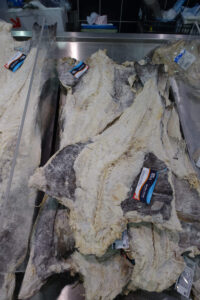

Instead, we ate on the balcony and were disappointed about eating pies from Spain, cream cheese from a large cheese dairy in Lisbon, and desert from Germany while being in the Portuguese countryside. How exciting, we had not even seen regional products in the supermarket. Even the dried cod was from Norway!
Anyway. We sat on the balcony in perfect peace and quiet, watched the bunnies hop around (Yes, Hispania was the province which is always connected as personification with the hare!), and enjoyed life.
Saturday, 11 April 2015 – Arraiolos
When we woke up this morning, the sun was shining. It did not stay like this for long though. Soon the landscape was shrouded in thick fog so that even the nearby Arraiolos on the opposite hill disappeared as if the little town had never existed.
Our plan for today was to explore the near vicinity after breakfast. The first destination was not even 10 footsteps away from the Pousada’s entrance. The gorgeous church of the convent is completely covered in tiles. The order, originally housed in the convent “Our Lady of the Conception”, is pretty unknown. But the many tiles in the church told their own story. The story of the Brothers Hospitallers of St John of God.
Their founder is pretty unknown around here, wrongly if you ask me because he definitely is one of the more likeable saints. He was born very close to Arraiolos, in Montemor-o-Novo, right off the next highway exit. His byname “a deus” indicates that John must have been a foundling who made a career as lansquenet under Charles V. Allegedly he travelled as far as Genoa, Innsbruck, Linz, and even Vienna. In 1538 John settled in Gibraltar, where he opened a flourishing book shop. Less than a year later, John had a religious enlightenment experience. On hearing a sermon he gave away all his belongings and ended up in the madhouse for a while. The times where such “madness”, like that of Saint Francis of Assisi, had been revered were long gone.
The following weeks in the madhouse were formative for John of God. When permitted to leave the institution, he put all his energy towards establishing hospitals for the mentally ill himself and providing humane care for the patients. He impressed even the upper class. For instance, Philip II of Spain himself donated money towards building more hospitals. It is said that John died on March 8, 1550, because he tried to save a boy, who had been carried away by the floodwaters of a river, from drowning. As I said, a saint you would happily identify with for once.
Arraiolos itself is probably a lot older than Evora and Beja together. It is assumed that the castle with its unusual circular shape was continuously inhabited since the Bronze Age.
Being here today you would not believe something ever happened in this town. Arraiolos is a dullsville. There are a few bars and several restaurants but locating a grocery store takes a while. Young people? Nada. On this gorgeous, sunny Saturday morning only old men had come together in the main square to drink their coffee or beer respectively. It was loud. Everybody seemed to know everybody. People were exchanging lively banter across the whole square. We sat there maybe for an hour and took pleasure in the atmosphere. We saw exactly two younger people in this one hour. A female bartender and a young man, who crossed the square by greeting every one of the older gentlemen with a handshake.
This picture did not change when we walked across town to hike up to the castle. Working in the vegetable garden, resting on the bench in front of the house, or shopping at the supermarket. The average age was well over 65. Well, the question remains open what exactly any young person would want in this village.
The next village, Pavia, was no better. Again we stopped at the village square. This time we did not get a drink in a bar but instead admired a dolmen that had been transformed into a church. Meanwhile we were being watched by at least 20 gentlemen, all of them old enough to be retired.
We kept driving through Pavia until we got to the main church (closed) and the adjacent cemetery. We figured that since we were here anyway, we might as well go take a look. It was fascinating. All tombs were made from marble. The wealthiest families had built small chapels for their dead, in which the wooden coffins were openly displayed on marble shelves. We thought that was pretty unusual.
Despite a number of detours in search of well hidden dolmens (no, we did not find all of them), we enjoyed the gorgeous day and the even more gorgeous landscape. Blooming meadows interspersed with cork oak groves, cow herds, sheep herds, avenues, and barrier lakes. When the sun is shining, Portugal is an enchanting country. (Less so in the pouring rain. Luckily, the weather forecast predicted more sunshine for tomorrow.)
In the next episode, we enjoy a fresh breeze at the summer residences of the Portuguese kings, Cascais and Sintra. The episode is dedicated especially to Mrs Schäfer from the Heidelberger Münzhandlung.
Here you will find all episodes of our series “Global Power Portugal”.




